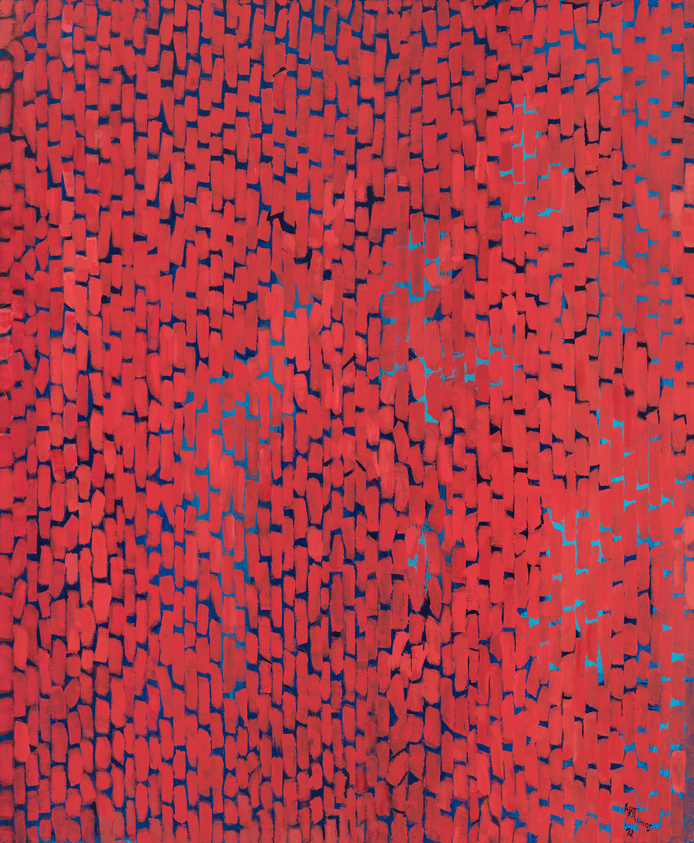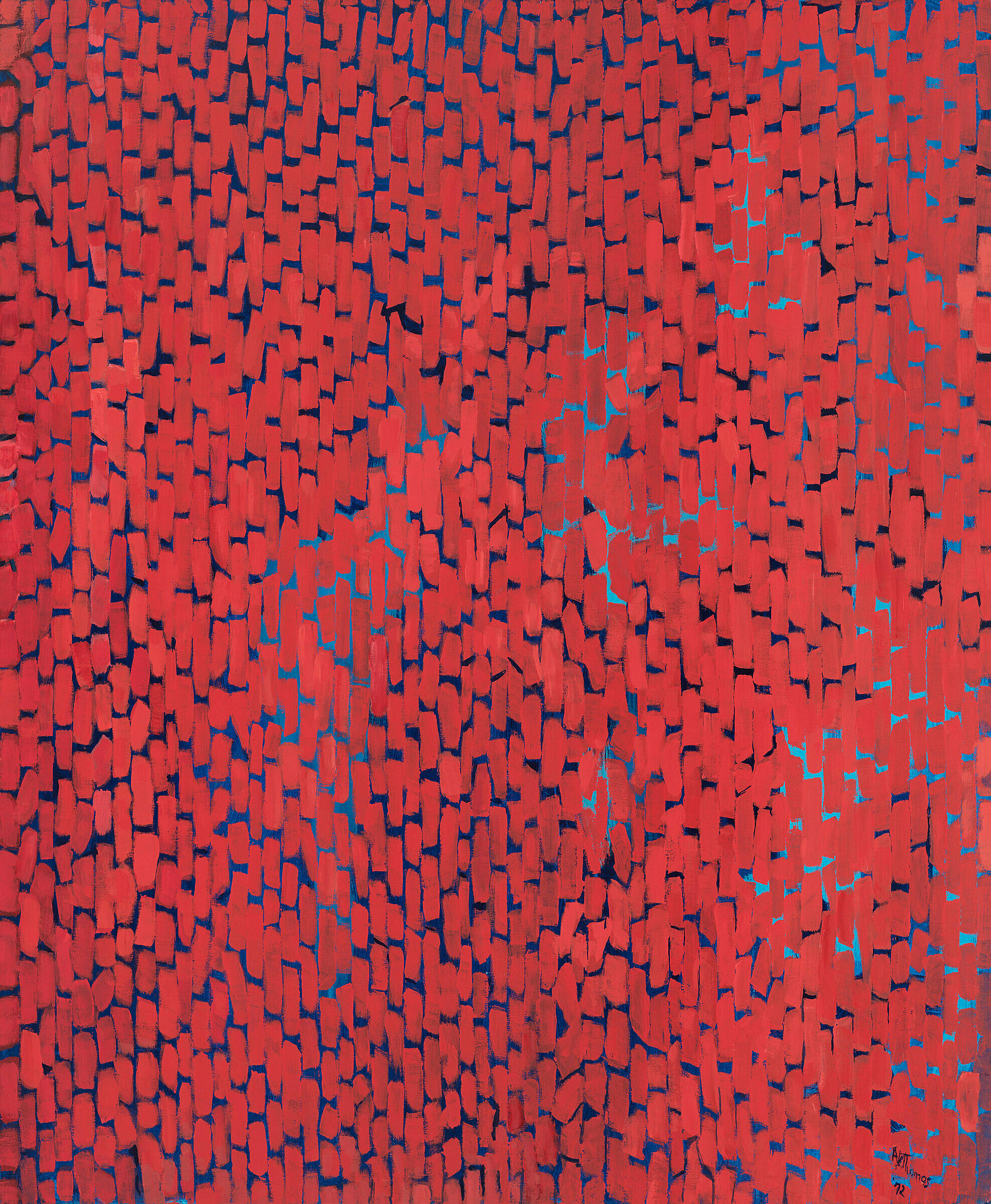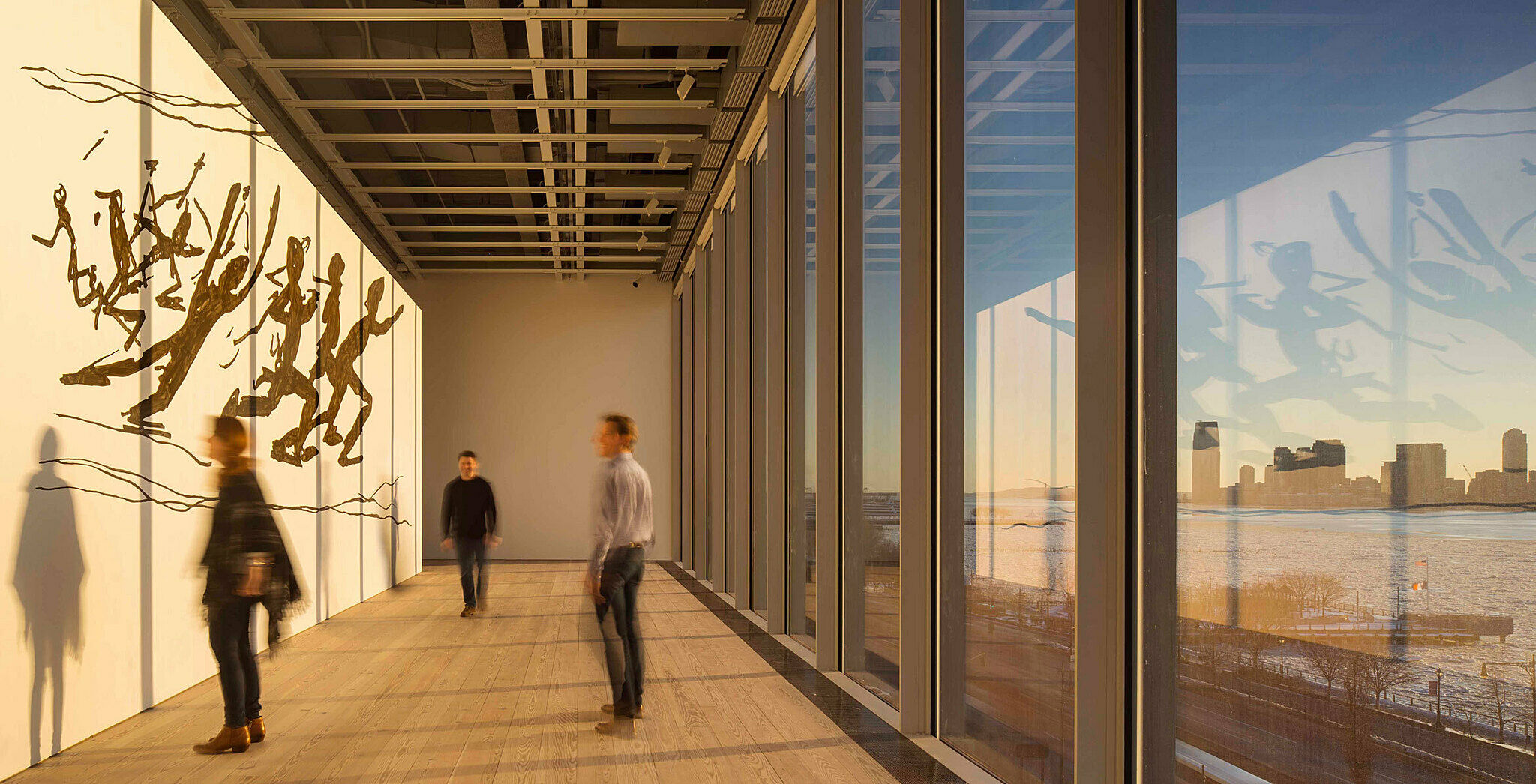Not on view
Date
1972
Classification
Paintings
Medium
Acrylic on canvas
Dimensions
Overall: 69 1/4 × 57 1/8in. (175.9 × 145.1 cm)
Accession number
72.58
Credit line
Whitney Museum of American Art, New York; purchase, with funds from The Hament Corporation
Rights and reproductions
© artist or artist’s estate
API
artworks/3043
Visual Description
Alma Thomas,Mars Dust, 1972.Mars Dustis an acrylic painting on canvas. The painting measures 69 ¼ inches tall by 57 ⅛ inches wide. The background of the painting is primarily a cool, dark blue with lighter blue tones and tints coalescing into washy expanses. On top of the blue, hundreds of short, warmer, red vertical brush strokes rest in a dazzling array. These marks are each about the size of an adult thumb. Not all of the reds are the same tint; some of the strokes are a whisper whiter than others. The brush strokes are deliberate and purposeful, averaging in similar thicknesses though some are slightly longer than others. The brush strokes are opaque and bristle marks are not apparent. The strokes are ordered so that sometimes they touch side to side (and very rarely top to bottom), often leaving small spaces between them, like vertically arranged bricks. These small spaces allow the blues to poke through, appearing as if seen through a sieve.
Thomas strikes a delicate and evocative balance in her use of positive and negative space. This texture brings about the illusion of dust storms on mars placed vertically, as if the viewer is peering down upon them.
Thomas cites the scientific advancements of the “space age” and color television as being pivotal in the conception of her creativity, and as an influence for this painting. Knowing this, her use of color is especially important, reflecting the vibrancy that would have been broadcast on technicolor TV screens. The mutability of the painting’s surface makes a gentle gesture towards the realms that cannot be visually grasped, towards the unknown hopes, aspirations, dreams, and illusions that lie in humankind’s probing of the universe. This question may point to the wonders of space lying not in what we know, but in what we cannot know.
Audio
-
Verbal Description: Alma Thomas, Mars Dust, 1972
From In the Balance: Between Painting and Sculpture, 1965–1985 (Verbal description)
0:00
Verbal Description: Alma Thomas, Mars Dust, 1972
0:00
Narrator: Alma Thomas, Mars Dust, 1972. Mars Dust is an acrylic painting on canvas. The painting measures 69 ¼ inches tall by 57 ⅛ inches wide. The background of the painting is primarily a cool, dark blue with lighter blue tones and tints coalescing into washy expanses. On top of the blue, hundreds of short, warmer, red vertical brush strokes rest in a dazzling array. These marks are each about the size of an adult thumb. Not all of the reds are the same tint; some of the strokes are a whisper whiter than others. The brush strokes are deliberate and purposeful, averaging in similar thicknesses though some are slightly longer than others. The brush strokes are opaque and bristle marks are not apparent. The strokes are ordered so that sometimes they touch side to side (and very rarely top to bottom), often leaving small spaces between them, like vertically arranged bricks. These small spaces allow the blues to poke through, appearing as if seen through a sieve.
Thomas strikes a delicate and evocative balance in her use of positive and negative space. This texture brings about the illusion of dust storms on mars placed vertically, as if the viewer is peering down upon them.
Thomas cites the scientific advancements of the “space age” and color television as being pivotal in the conception of her creativity, and as an influence for this painting. Knowing this, her use of color is especially important, reflecting the vibrancy that would have been broadcast on technicolor TV screens. The mutability of the painting’s surface makes a gentle gesture towards the realms that cannot be visually grasped, towards the unknown hopes, aspirations, dreams, and illusions that lie in humankind’s probing of the universe. This question may point to the wonders of space lying not in what we know, but in what we cannot know.
-
Alma Thomas, Mars Dust, 1972
From In the Balance: Between Painting and Sculpture, 1965–1985 (Spanish)
0:00
Alma Thomas, Mars Dust, 1972
0:00
Lauren Haynes: Esta obra, Mars Dust, fue creada en 1972.
Narrator: Lauren Haynes es la directora de Asuntos Curatoriales del Queens Museum. En 2015, analizó esta obra de Alma Thomas como parte de una serie de charlas de galería en el Whitney, llamada 99 Objects. Puede escuchar todas estas charlas en nuestro sitio web.
Lauren Haynes: En esta obra, el azul cobalto y el azul más oscuro están debajo de las bandas rojas que creó con una bandita elástica, para formar las distintas capas. Los distintos niveles de rojo constituyen su interpretación del polvo, de esta tormenta de polvo y de la manera tan sobrecogedora en que el rojo se apodera del lienzo y cómo el polvo “absorbió” a Marte, planeta que conocemos como el planeta rojo.
En 1969, más o menos en la época de las misiones espaciales Apolo—cuando vimos a los primeros astronautas estadounidenses sobre el suelo de la Luna y hubo toda una serie de distintos aterrizajes y exploraciones—Alma Thomas se involucró de lleno en este tema. Le fascinaba la idea del espacio, pero también el modo en que la tecnología nos abrió las puertas para que todos pudiésemos ver qué estaba ocurriendo. Tiene una cita que es maravillosa: “Nuestros excelentes científicos y astronautas no solo pueden ir a la Luna y volver para fotografiar la superficie y traer muestras de rocas y otros materiales, sino que gracias a la televisión a color, todos podemos ver y experimentar la emoción de estas aventuras. Estos fenómenos pusieron en marcha mi creatividad.”
-
0:00
Alma Thomas, Mars Dust, 1972
0:00
Lauren Haynes: So this work, Mars Dust, was created in 1972.
Narrator: Lauren Haynes is the Director of Curatorial Affairs at the Queens Museum. In 2015 she discussed this work by Alma Thomas as part of a series of gallery talks at the Whitney, called 99 Objects. You can listen to all of these lectures on our website.
Lauren Haynes: With this work, which has the cobalt blue and the darker blue underlay with the red bands that she made using an elastic band to sort of create the layers. And the different levels of red are her interpretation. I think of dust and this dust storm and this very overwhelming way that the color red is taking over this canvas and how the dust sort of took over Mars, which we know as the red planet.
In 1969, around the Apollo space missions, when we sent the first American astronauts to the moon, and there was a whole series of different landings and explorations, Alma Thomas got very caught up in that. She was really interested in this idea of space, but also the way that technology opened the door for everyone to be able to see what was going on. She has a really great quote: “Today not only can our great scientists send astronauts to and from the moon to photograph its surface and bring back samples of rocks and other materials, but through the medium of color television, all can actually see and experience the thrill of these adventures. These phenomena set my creativity in motion.”
-
0:00
August 22, 2015
Lauren Haynes on Mars Dust by Alma Thomas0:00


